Taming Trees
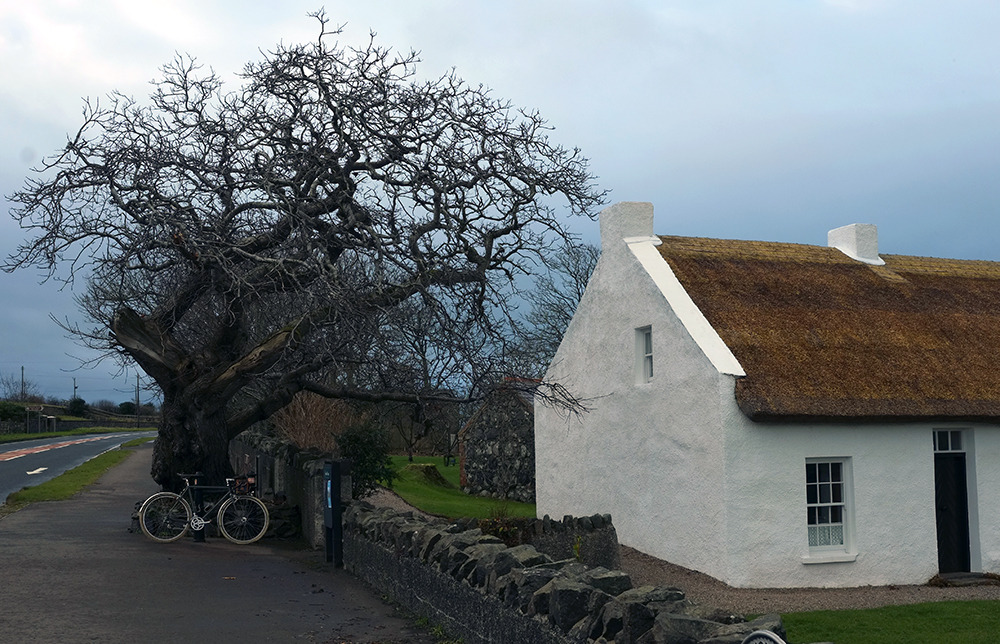
I consider the question seriously, closing my eyes and allowing for an image to develop in my mind's eye like a photographic print.
"Well, for starters - there's the trees."
"The trees? What about them?"
"They're all crooked. You know - twisted, bent, warped. They look like they creep and swoon and reach out for things, rather than just grow as normal trees do. "
On the other end there is silence. Then: "Hey. Are you sure you're all right over there?"
"What? Oh of course. I'm just saying. The trees..."

I used to ask the locals what kind of trees they were at first - having assumed that they were a specific species, as their chaotic forms shared such a distinct aesthetic. But soon I understood that nearly any tree growing in Ireland takes on this twisty, meandering, almost ivy-like quality. Be it oak, ash, willow, rowan or pine, over time the crookedness eclipses any distinguishing features of its species, until a Chestnut looks more similar to a Hawthorne than one might ever imagine possible.
What causes this distorted growth in the trees dominating the landscape? The logical assumption is that the strong winds are at fault. This is most obvious in exposed areas, where you can tell the dominant wind direction by the perma-bend of the trees. Even the cabbages grow crooked! But what then of the crooked trees in dense forests?
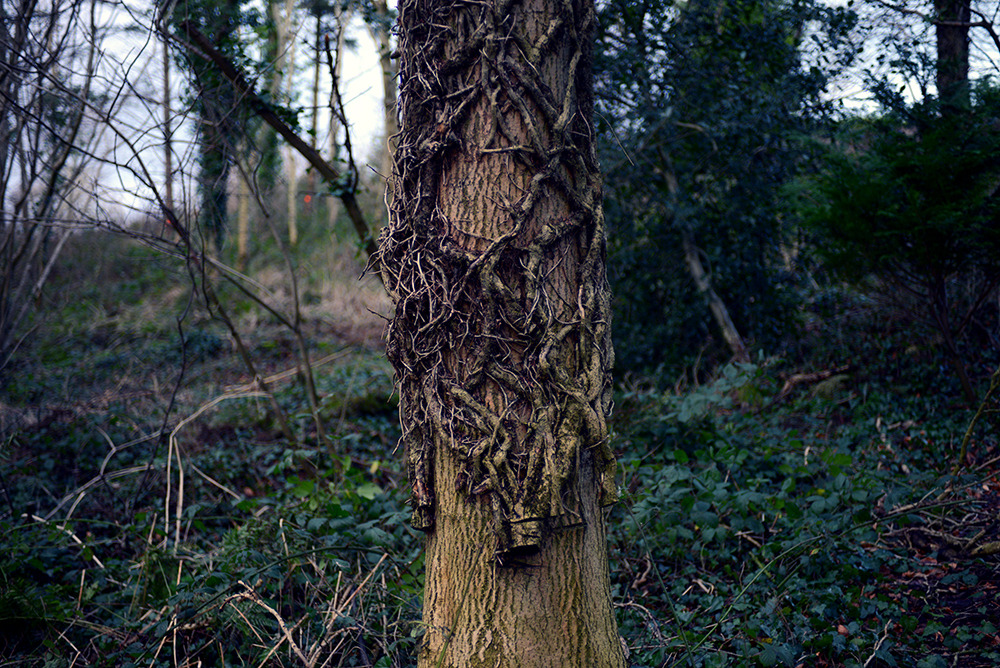
How the vines manage to arrange themselves in braided, almost geometric patterns is another wondrous feature of the trees. Often the vines are cut off at the roots by those who wish to see the tree live. But rather than shriveling up and falling off, the vines become petrified in place, clutching the tree and stunting its growth even while lifeless. What would those trees now look like with the vines forcibly removed, I have often wondered when cycling past these grotesque living statues.
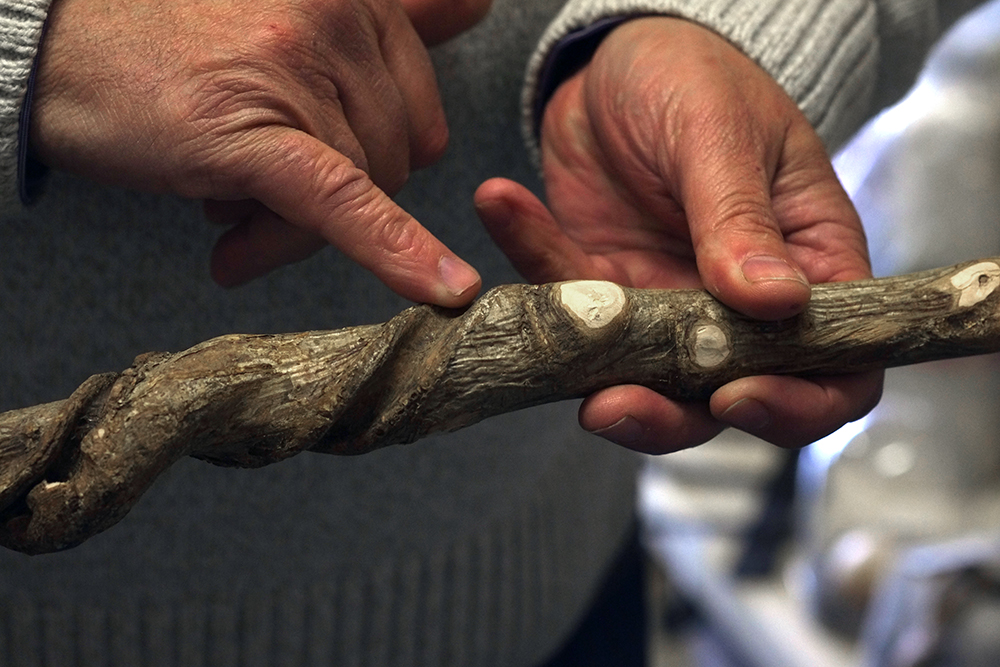
Unexpectedly that question was answered for me one day as I happened past a shop window in the small market town of Limavady. Inside its crafts and furnishings filled interior, a friendly looking gentleman was standing next to a vise in which appeared to be clamped a long wooden stick. To my delight I realised this person was making a shillelagh - a traditional Irish walking stick. Unable to help myself, I stopped my bike and walked in.
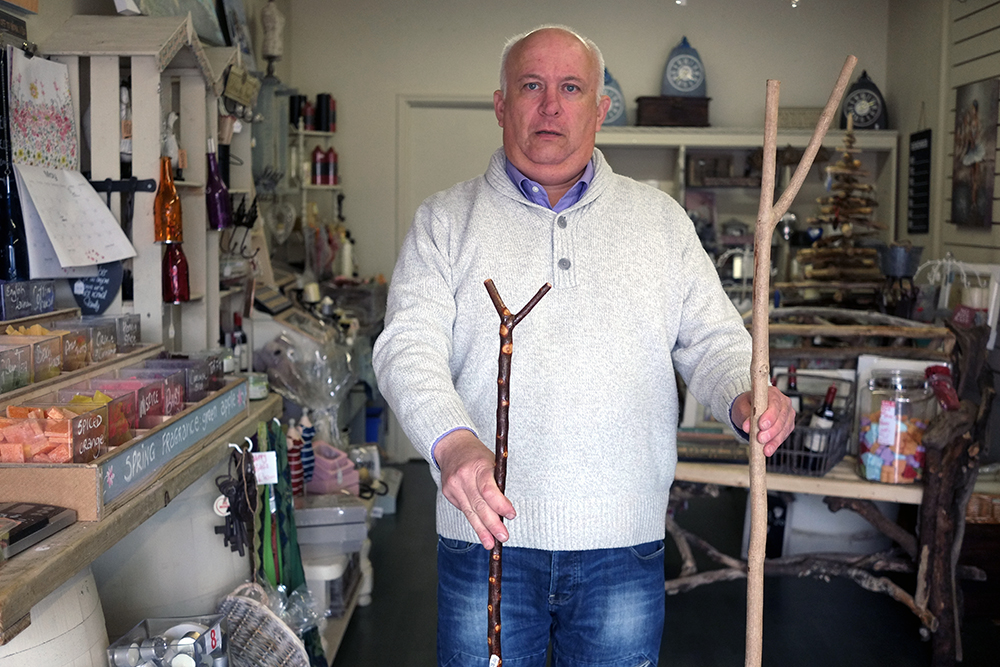
While, admittedly, my personal interest in shillelaghs is limited, I receive a surprising number of queries from American readers regarding where to purchase a "genuine" one. Happily, I am now equipped to advise on this matter: You can purchase a most assuredly genuine shillelagh, custom made to your specifications, from Raymond Boyd (raymondboyd23-at-hotmail-co-uk) - for a price that I assure you is gasp-evokingly reasonable.
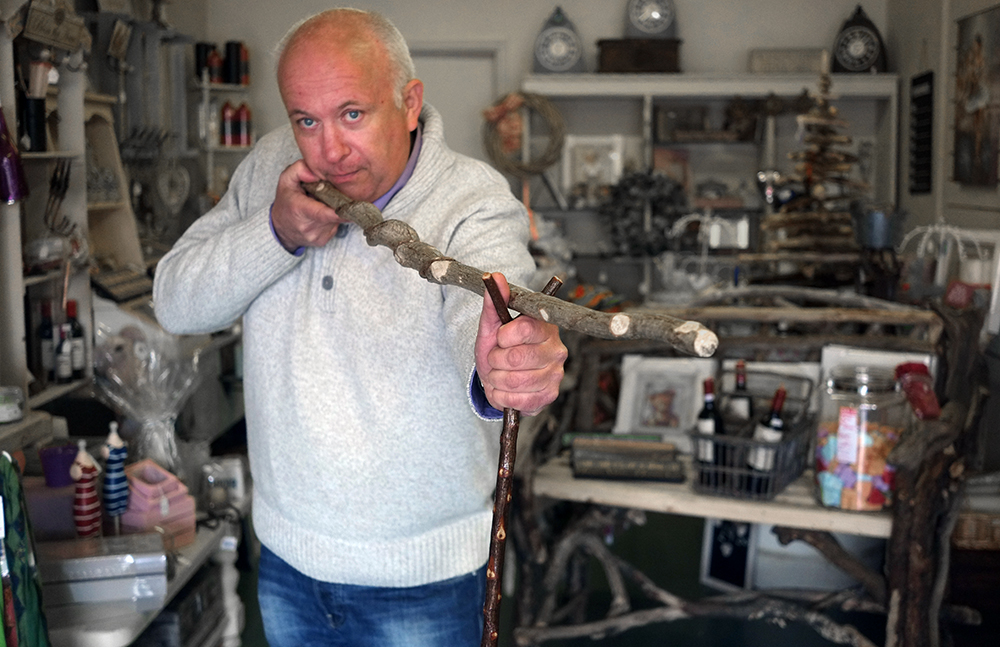
After explaining the difference between shillelaghs used for walking, shooting, shepherding, and even fishing (see: "priest"), Raymond showed me his process for making them.
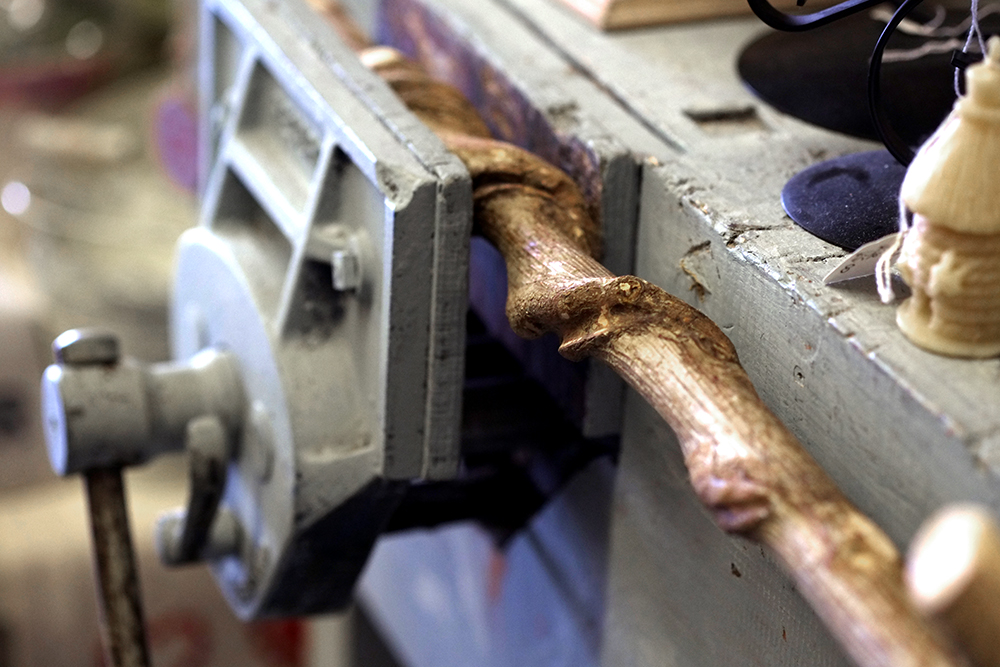
Because the sticks are made out of branches - most often hawthorn and blackthorn - which are inevitably quite crooked, after being trimmed, de-barked and cut down to size, they need to be straightened. This is done by steaming them, then drying them in a vise - a process that sometimes calls for several attempts.
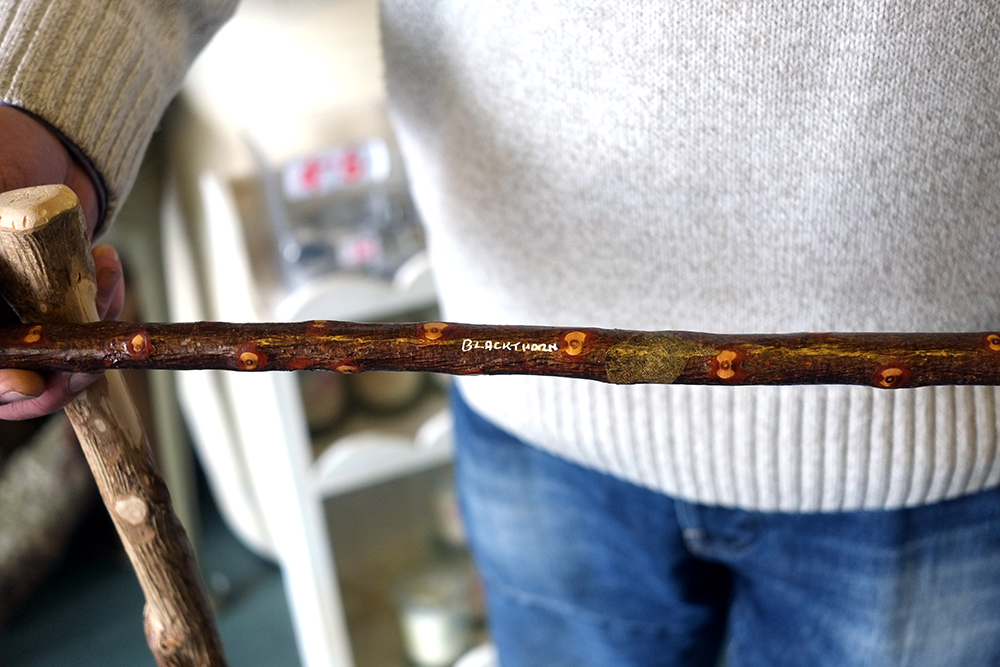
Afterward, the sticks are cured, painted or lacquered, depending on the look and feel one is going for. Often decorative embellishments are added. Because the Roe Valley area is known for its salmon fishing, local makers of shillelaghs will sometimes decorate the sticks with tiny images of salmon.
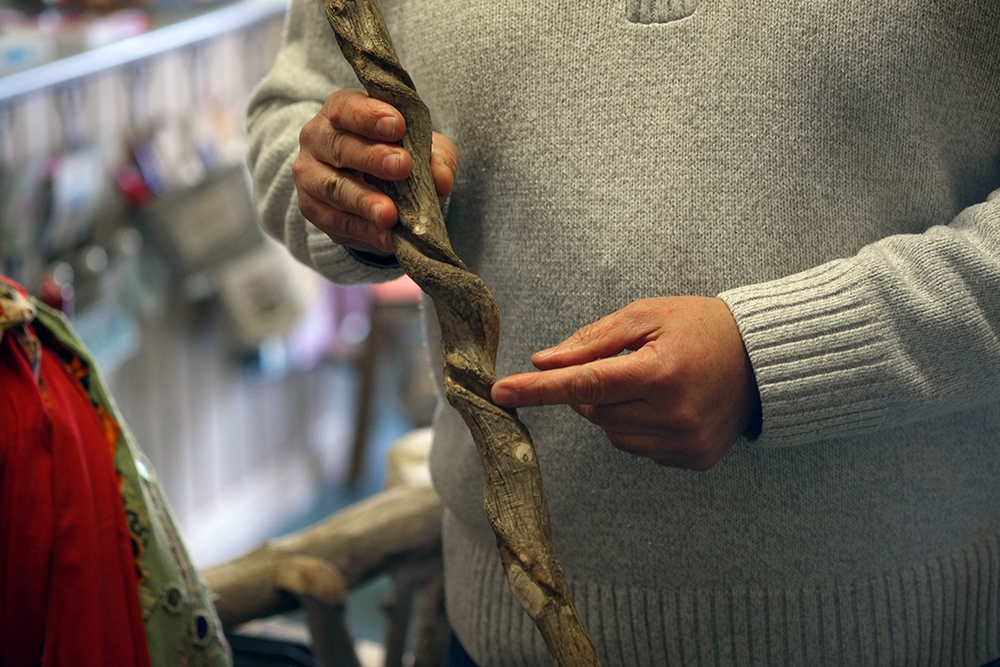
But by far the most prized embellishments are the natural variations in the wood - such as the spiral indentations made by those braided choking vines, for instance.
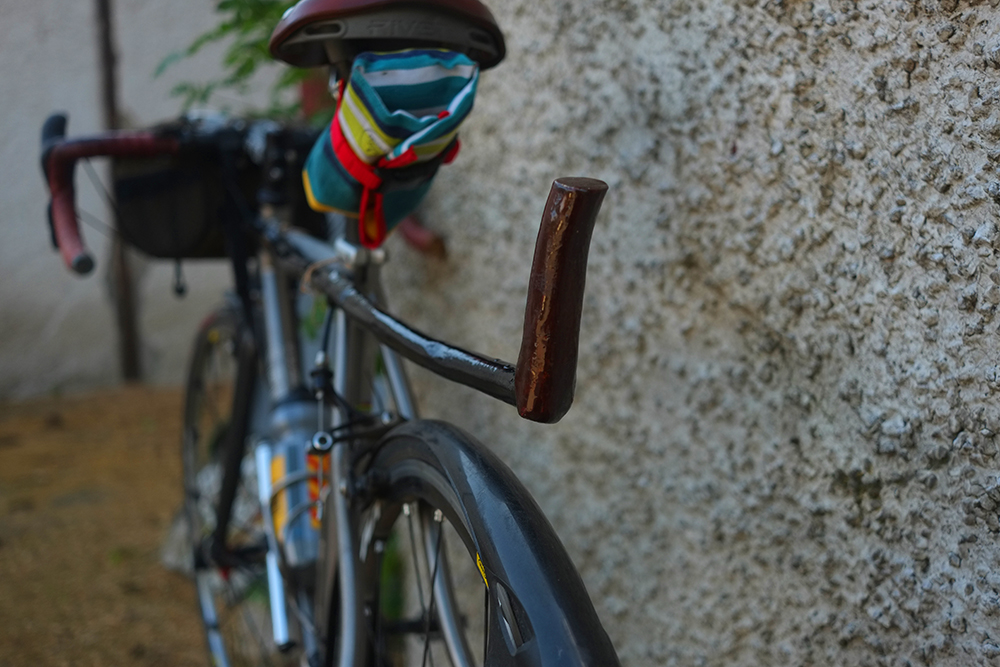
Having eyed up a modest shillelagh that I wanted to buy as a gift, I wondered out loud whether it was a good idea to cycle with it (this was only the start of my ride, and I had planned to do about 30 miles).
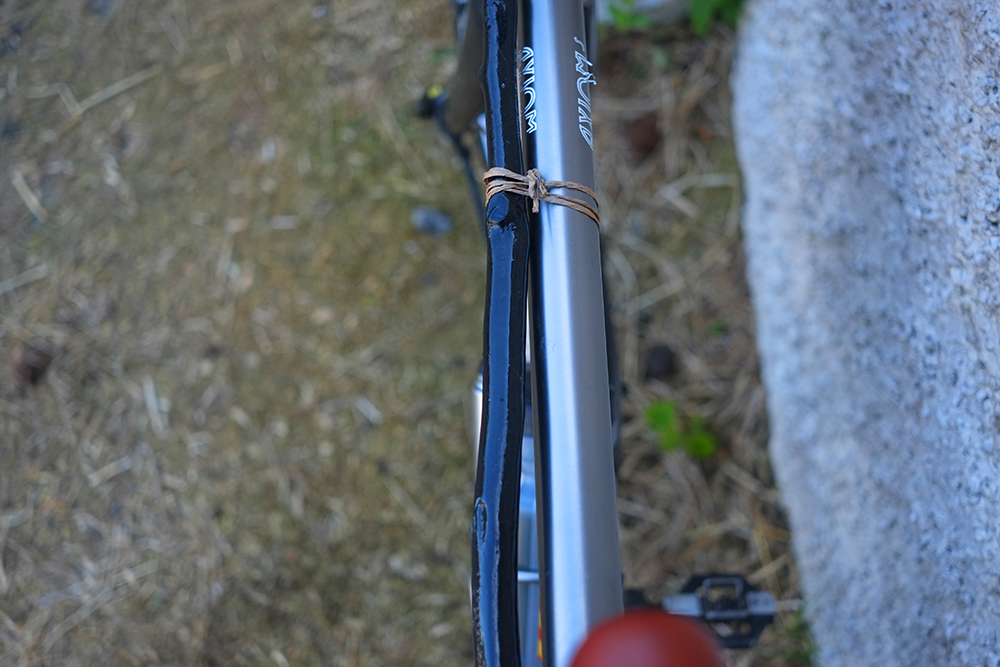
Next thing I knew, we were attaching it with twine to my bicycle's top tube, the usual "Ach it'll be grand!" reassurances uttered. And funny enough - other than increasing my q-factor by a bit - the shillelagh was hardly noticeable. Staying in place for the duration of my ride it remained horizontally stiff and vertically compliant.

As I made my way home with a lacquered wooden stick tied to my top tube, I thought of the absurdity of it. Moreover, I thought of the absurdity and the loveliness of all those twisted crooked trees peppering the landscape. Even as we struggle to bend a stick into shape, it's the traces of crookedness that make it most charming, iconic, beloved and valuable. It is the same with the roads we love to travel on. And with the people we love to love. And with the thoughts and feelings we try to wrangle into forms we think they ought to have, only to be delighted when these thoughts and feelings surprise us by disobeying. The trees all around me, in their knotted untamable twistieness, appear to nod in agreement as they sway in the westerly wind.

Question: did you think of the tt strapping or did the maker?
ReplyDeleteThought of it all by myself. But his twine was a nice touch compared to the shabby bit of rope I was planning to use.
DeleteAnd a beautifully executed knot, to boot.
DeleteA couple years ago….Road bike, hardware store, rake and shovel and a bit of twine, and a similar set-up. Worked fine. The hardware folks were scratching their beards at first but then admitted, 'yup' you're good to go.
DeleteI've used the same method to carry a broom. When I posted it on Facebook, I was asked if it was a flying bike. It would actually make a great Halloween bike idea!
DeleteI've carried stuff tied to my top tube before; it's sort of the obvious place to attach anything long and narrow. But normally when this happens it's on my way home, with just a few miles to go. This was my first time incorporating TT-portage into an actual 30+mile road ride, which stepped things up a notch.
DeleteBelieve me, you're not the first by a long shot ;)
DeleteOh I'm sure there's a "stuff I tied to my top tube today" flickr group. And hashtag.
DeleteI’ve been trying to figure out a way of getting a 6 ft. length of scaffolding pipe home from the builder’s yard to use as a cheater bar to remove a resolutely stuck bottom bracket fixed cup, and I guess this would be the only way to do it by bicycle (it’s four buses otherwise). My Q-factor will be increased more than a bit – I figure I might have to lower the saddle, go ‘bandy-legged’, splay my feet and pedal with my heels – and I might get some funny looks, but it would be worth the effort – the fixed cup has been stuck for years and the LBS couldn’t shift it. I’ll probably walk like a cowhand afterwards, but thanks for the idea.
DeletePretty, Velouria! I like too that your narrative is a beguiling meander itself in mirror to "the traces of crookedness" that beautify our world. The destination you've led us to is a nice place to be. Thank you. Jim Duncan
ReplyDeleteI love the Live Oaks around here. It's definitely the trees where I live too. All gnarled, twisted and ancient looking.
ReplyDeleteBeautiful photos and great topic - I had no idea how these such walking sticks were made - and your creative writing ties it all together. Happy cycling in such an enchanted landscape.
ReplyDeleteThank you for this beautiful reflection. One of the gifts of bicycling is being closer to nature wherever we are and feeling the forces of wind, rain, sun, cold, and warmth experienced by all living things in our own bodies and spirits.
ReplyDeleteLovely article. I found your blog just recently and am thoroughly enjoying it.
ReplyDeleteI tried to get in touch with Raymond Boyd about purchasing one; but the address you provided failed. Could you fix me up with a good one. Thanks so much.
Sorry - It's a @hotmail.co.uk address (I didn't specify the UK part).
DeleteIf that doesn't work, phone him at +447849417800
When I think about my fantasy Bike Grand Tour through Britain and Europe, I always wonder how I'm going to ride more than a few miles a day for all the stopping to draw stone bridges, cottages and trees. When I look at your pictures of Ireland I realize I should just skip that place altogether or just leave the bike somewhere and plan on spending a month filling sketchbooks with trees.
ReplyDeleteWe've planted many dozens of trees on our 3 acres and nurtured some of the volunteers as well (although the war I'm waging on the Honey Locust and Mulberry is becoming decidedly grim and bad-natured), my favorites are the ones that have taken on strange shapes and postures, developing personalities and character the crayon drawing lollipop trees never will. There's a Hickory that apparently thinks it's an acacia, branching low and beginning to spread wide to embrace the yard instead of shooting up to scrape the clouds out of the sky like the others I planted the same day.
At our old house I encouraged 2 scrubby Maples that appeared by the fence in the back yard till they were 8 foot tall beauties with crooked stems and various branches gesturing like Kabuki Dancers. Than one day while I was at work my Father In Law pruned them into submission, turning them from fabulous future sites for tree houses and daydreaming to crippled War Wounded. Absolutely Great Guy, wretched Arborist. I came home from work that evening, saw those poor unfortunate things standing humiliated in the yard and had to make myself stay chill and remember that I cared more for my Father In Law than I did for a couple of trees. When I would look out the window and see those Maples I'd just say "screw it" and apparently that's what the trees did too, just said "screw it" and never really recovered from the insult. They were the first and only things to give up and die when we had 2 summers of drought a few years later. I suspect Irish trees would have risen up in Vengeance and Malice and taken over the yard...
Spindizzy
"Dentritic trees", your beautiful first picture reminds of this phrase to me (written by yourself, I don't know when).
ReplyDeletePowerful winds make their own bonsai.
In my country it's said that your coastal area provides special qualities of grey: for example a kind of blue with a small touch of acid green ....
L.
Here in Southern England a lot of the trees look weird (compared to the US) because of ancient pollarding and coppicing.
ReplyDeleteBlackthorn sticks used to be standard issue for officers in Irish regiments and they would carry them on parade (I don't know if this is still the case)
ReplyDeleteI have several blackthorns passed down by my father, who was in the army. They have the regimental badge mounted on their head.
For some reason, he always used to refer to them as a blackthorn, rather than a shillelagh, whereas his military headgear was referred to using the Irish derived word "caubeen".
People tend to call them blackthorns here as well. Could be because the original Irish which "shillelagh" is based on actually means "willow."
DeleteThank Veloria for this post. It isn't only about the bicycle, but about what it helps us discover. Now if you will excuse me I am off to browse images of fishing priests!
ReplyDeleteI'm surprised that North America isn't more windy and better provided with twisted trees than we are! Where does Tim Burton get his aesthetic from?
ReplyDeleteCiaran, Belfast
For countries lacking in such resources, I am sure sightings of Irish-style trees can be achieved with chemical help.
DeleteYour comment about chemicals is thought provoking.
DeletePerhaps, and I'm merely speculating here, Irish tree's are no different in appearance than any other, and the perceived differences may be accounted for by possibly altered perceptions of the people who live in Ireland?
There's a certain amount of cultural evidence to prompt one to consider the possibility. The preponderance of locally produced liquid dietary supplements for one, the long history of fantastic fauna and mystics, etc. And of course the whole James Joyce thing defies conventional explanation.
I am from Texas after all, so the idea that a place may affect the people who live there in unaccountable ways is not new to me... It can't all be caused by Diesel fumes and Peat smoke or Bushmills and Lone Star, but...
Spindizzy
Someone should weld a do-hickey that resembles the lines of this staff and call the bike an Urban Racer and sign it Sacha White, designer to the new cognoscenti. Or something.
ReplyDeleteShillelagh is one of my new favourite words. I don’t live in Ireland but I’d want one, not just to go out walking with but so that I can tell everyone what it’s called. Blackthorn berries are sloe berries, apparently (the things I learn from your blog!), so if Raymond tells you where he gets his sticks you could make some sloe gin or vodka or whiskey or cider or whatever. And then write a post about what it’s like to cycle when you’re drunk (if you can remember!) – you could call it “CUI”... :)
ReplyDeleteI can't quite identify the fountain pen in the photo, tell about it. I'm sure there are other cyclists who are devoted to them.
ReplyDeleteAssuming you're asking about the June 8th post here. It's a Conklin Crescent filler with a stub nib.
DeleteI'm wondering if the trees' distinctive shape has something to do with the combination of relatively mild weather with very low light levels. That or may be the little folk swinging on them all night...
ReplyDelete